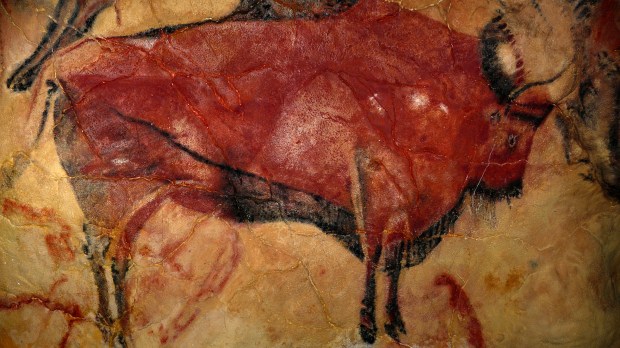Lenten Campaign 2025
This content is free of charge, as are all our articles.
Support us with a donation that is tax-deductible and enable us to continue to reach millions of readers.
I’m heading to snowy Willimantic, CT this afternoon, to the Immaculata Retreat House, where I’ll lead the convocation of deacons for the Diocese of Norwich this weekend. I won’t be preaching for Epiphany (or, chanting the date of Easter, alas), but here’s something from the vault:
+
On a summer’s day in 1879, an amateur archeologist named Marcelino de Satuola went into a cave in Altamira, Spain, looking for prehistoric artifacts. He’d been there several times before, and hadn’t found much of interest. But this day, he brought with him his five-year-old daughter. The two of them began to explore the cave. Marcelino was studying the ground, when he heard his little girl cry out. “Look, papa,” she said, “oxen!”
He couldn’t imagine what she was talking about, until he looked in her direction and saw she was pointing to the ceiling.
There, Marcelino saw the most incredible images: pictures of animals and people that had been left there over 10,000 years earlier. What his little girl spotted was later hailed as one of the greatest artistic discoveries ever. In the 1920s, Picasso visited the caves and came away awed. To this day, thousands visit Altamira every year to see what many consider to be the very beginnings of art
And it happened because a five-year-old didn’t look down.
She looked up.
She brought to that adventure a sense of wonder. Just like the magi, the wise men, in today’s gospel reading. They also looked up. And then looked forward. And then followed. They discovered something far more valuable than anything painted on the ceiling of an ancient cave.
They followed a star to the savior of the world.
And what led them there was more than astronomy. They were led by fascination, moved by wonder. They needed to find where that star would take them.
The biologist J.B.S. Haldane once said, “The world will not perish for want of wonders…but for want of wonder.”
Wonder. That is the great well-spring that nourishes us on this particular feast, the feast of the Epiphany. That word comes from Latin, “epiphania,” meaning “manifestation.” A revelation. Or, as Webster’s puts it, an “illuminating discovery.”
The magi discovered the greatest illumination of all: Christ.
Isaiah describes it this way: “Rise up in splendor, Jerusalem! Your light has come.”
And it has. The birth of Christ means we will finally see what was hidden. What was in shadow is bathed in light.
And it begins with the infinite light of a star.
But to see it, to experience it, to discover it, we need to do what the magi did. We need to have wonder. And we need to travel – to journey outside our “comfort zones” and be open to the unexpected or the unplanned.
The magi had no idea where the star would take them. They didn’t know what their final destination would be. They couldn’t anticipate what they would find, or that it would all end up in Bethlehem.
The journey to Jesus was, for them, as it is for all of us: unpredictable, uncharted, unknowable.
And it left them changed.
As Matthew writes: “They departed for their country by another way.”
After encountering Christ, they couldn’t travel the same road.
It should be that way for all of us. After discovering Jesus, after our own epiphanies, nothing can be quite the same.
John Henry Newman once wrote that “To live is to change.” It’s a beautiful thought for this season, when we’re starting a new year and many of us are struggling to change old habits – or maybe lose old weight.
Living is about growing, and changing – Newman embodied that with his conversion. So did other great converts of our own day, people like Edith Stein, Thomas Merton and Avery Dulles. They understood that life isn’t a destination. It’s a journey. No matter the problems, or detours or setbacks, we continue to move forward, seeking Truth.
The other day I read the remarkable story of two Anglican men, a father and son in England, who converted to Catholicism. That’s unusual enough. But then, just before Christmas both of them were ordained to the priesthood. It’s believed that’s the first time that’s ever happened. The son put it simply, but eloquently: “It was time to come home.”
What a homecoming.
This is a time, the holidays, when many of us have had homecomings of one kind or another. For some of us, that homecoming has also meant returning to the faith. Maybe you found yourself suddenly back in the pews for Christmas Mass — trying to remember the prayers you used to know by heart, feeling a little out of place, wondering if you’ll fit in. It’s okay.
The most important thing – like with the magi – is that you made the trip.
The fact is: all of us, like the magi, are pilgrims, on journey. But where will the journey take us?
Remember the wise men, the journey they took, the star they followed, the epiphany they made. They traveled to places unknown, guided by wonder. And they discovered the Son of God.
And remember, too, that little girl in Altamira.
So often, we spend our lives looking at the ground, studying the dirt, checking out the broken remnants of life that lie at our feet. We can miss the glory that is just above us.
We can miss epiphanies.
So: Look up! Look forward. And follow. Follow the light, the light that is Christ.
It leads us to grace.
And after that, we have no choice but to live differently – like the magi, returning to our lives “by another way.”
—Preached Epiphany Sunday 2009

